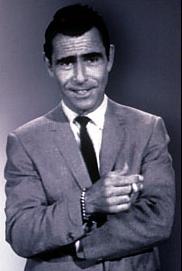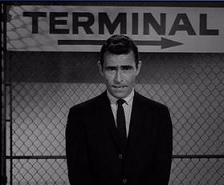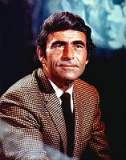Rodman Edward "Rod" Serling was born on December 25, 1924 in Syracuse, NY, the second of two sons of Esther Cooper and Samuel Lawrence Serling. His brother, Robert J. Serling, later became a novelist. Serling was raised in Binghamton, NY, where he later graduated from Binghamton Central High School. He earned his B.A. in 1950 from Antioch College in Yellow Springs, OH. Though brought up in a Jewish family, Serling became a Unitarian Universalist. Serling's family had a summer home on Cayuga Lake, in New York's Finger Lakes region, which inspired the name "Cayuga Productions" for use on Twilight Zone productions.

Serling served as a U.S. Army paratrooper and demolition specialist with the 511th Parachute Infantry Regiment, 11th Airborne Division in the Pacific Theater in World War II from January 1943 to January 1945. He was seriously wounded in the wrist and knee during combat and was awarded the Purple Heart and Bronze Star.
His military service deeply affected the rest of his life and influenced much of his writing. Due to his wartime experiences, Serling suffered from nightmares and flashbacks. During his service in World War II, he watched as his best friend was crushed to death by a heavy supply crate dropped by a parachute onto the field. Serling was rather short (5'4") and slight. He was a noted boxer during his military days (Rod Serling Timeline RodSerling.com).
In 1951, Serling started to break into TV by writing for The Doctor, Fireside Theater, Hallmark Hall Of Fame, Lux Video Theater, Kraft Television Theatre, Suspense, and Studio One. He also worked for local Cincinnati TV station WKRC (Channel 12), where he wrote a series of live TV shows titled The Storm. The program was a precursor to The Twilight Zone.
Tired of seeing his stories butchered (removing any political statements, ethnic identities, even the Chrysler Building being removed from a story sponsored by Ford), Serling decided the only way to avoid such artistic interference was to create his own show.

In 1959, CBS aired the first episode of a groundbreaking series,
The Twilight Zone. Serling fought hard for creative control, hiring writers he respected (such as Richard Matheson and Charles Beaumont) and launched himself into weekly television. He stated in an interview that the science fiction format would not be controversial and would escape censorship unlike the earlier
Playhouse 90. In reality the show gave him the opportunity to communicate social messages in a more veiled context.
Serling drew on his own experiences for many episodes, with frequent stories about boxing, military life and aircraft pilots, which integrated his firsthand knowledge. The series also incorporated Serling's progressive social views on racial relations and the like, which were somewhat veiled by the science fiction and fantasy elements of the shows. Occasionally, however, Serling could be quite blunt, as in the episode "I Am The Night — Color Me Black", where racism and hatred causes a dark cloud to form in the American South before eventually spreading elsewhere. Serling was also progressive on matters of gender, with many stories featuring quick-thinking, resilient women, although he also wrote stories featuring shrewish, nagging wives.
The show lasted five seasons (four using a half-hour format, with one half-season using an hour-long format), winning awards and critical acclaim for Serling and his staff. While having a loyal fan base, the program never had huge ratings and was twice canceled, only to be revived. After five years and 156 episodes, 92 of them written by Serling himself, he wearied of the show. In 1964, he decided to let the third cancellation be final.
Serling sold his rights to the series to CBS. His wife later claimed that he did this partly because he believed the studio would never recoup the cost of the show, which frequently went over budget. This proved to be a costly mistake.

In 1969, NBC aired a Serling-penned pilot for a new series,
Night Gallery. Set in a dimly lit museum, the pilot film featured Serling (as on-camera host) introducing three tales of the macabre, unveiling canvases that would appear in the subsequent story segments.
The series, which premiered in December 1970 (its brief first season rotated as one spoke of a four-series programming wheel titled Four in One), focused more on gothic horror and the occult than did The Twilight Zone. Serling, no longer wanting the burden of an executive position, sidestepped an offer to retain creative control of content—a decision he would come to regret. Although discontented with some of producer Jack Laird's story and creative choices, Serling maintained a stream of creative submissions and ultimately wrote over a third of the series' stories.
By season three however, Serling began to see many of his story contributions rejected. With his complaints ignored, the disgruntled host dismissed the show as "Mannix in a cemetery".
Night Gallery lasted until 1973.
Serling also wrote a number of screenplays with a political focus, including
Seven Days In May (1964) about an attempted military coup against the President of the United States,
Planet Of The Apes (1968), and
The Man (1972) about the first African American President.
Late in his life, Serling taught at Ithaca College in Ithaca, NY where he resided for many years, and did voiceovers for various projects. He narrated documentaries featuring French undersea explorer Jacques-Yves Cousteau. Other documentaries he voiced were:
In Search Of Ancient Astronauts (1973),
Monsters! Mysteries Or Myths? (1974),
The Outer Space Connection (1974),
Encounter With The Unknown (1975), and
UFO's: It Has Begun (1979).
On June 28, 1975, Serling was mowing his lawn, when all of a sudden, he began to experience some chest pains, and collapsed. His neighbor found him and called the ambulance. When he arrived in the operating room, the doctors saw that the artery leading to his heart was disintegrating and there was no hope for him. He died later that day in the hospital at the age of 50. He is interred at the cemetery in Interlaken, an area of upstate New York featured prominently in some Twilight Zone episodes.
Excerpts from Wikipedia, the free encyclopedia.









 Serling served as a U.S. Army paratrooper and demolition specialist with the 511th Parachute Infantry Regiment, 11th Airborne Division in the Pacific Theater in World War II from January 1943 to January 1945. He was seriously wounded in the wrist and knee during combat and was awarded the Purple Heart and Bronze Star.
Serling served as a U.S. Army paratrooper and demolition specialist with the 511th Parachute Infantry Regiment, 11th Airborne Division in the Pacific Theater in World War II from January 1943 to January 1945. He was seriously wounded in the wrist and knee during combat and was awarded the Purple Heart and Bronze Star. In 1969, NBC aired a Serling-penned pilot for a new series, Night Gallery. Set in a dimly lit museum, the pilot film featured Serling (as on-camera host) introducing three tales of the macabre, unveiling canvases that would appear in the subsequent story segments.
In 1969, NBC aired a Serling-penned pilot for a new series, Night Gallery. Set in a dimly lit museum, the pilot film featured Serling (as on-camera host) introducing three tales of the macabre, unveiling canvases that would appear in the subsequent story segments.